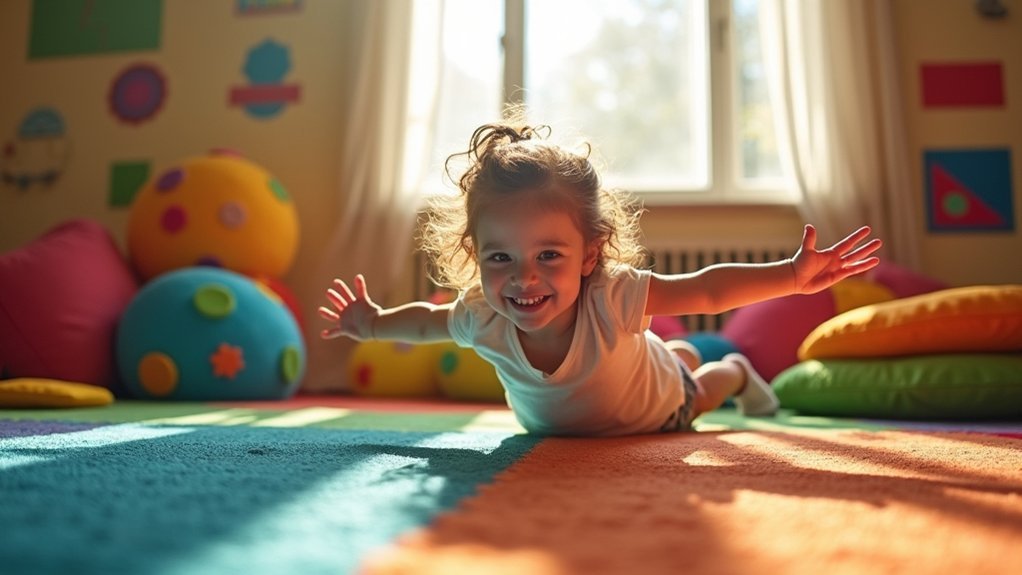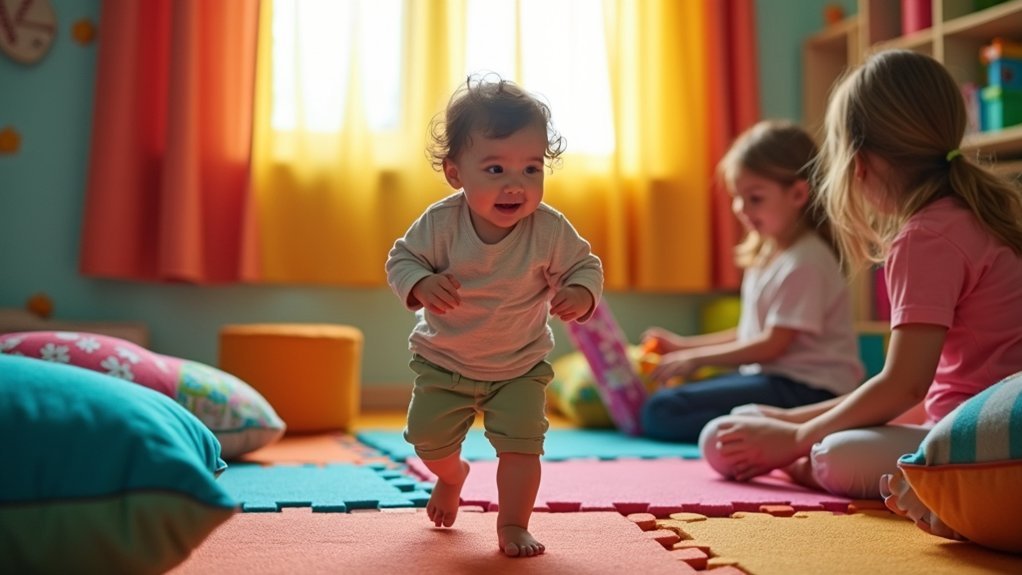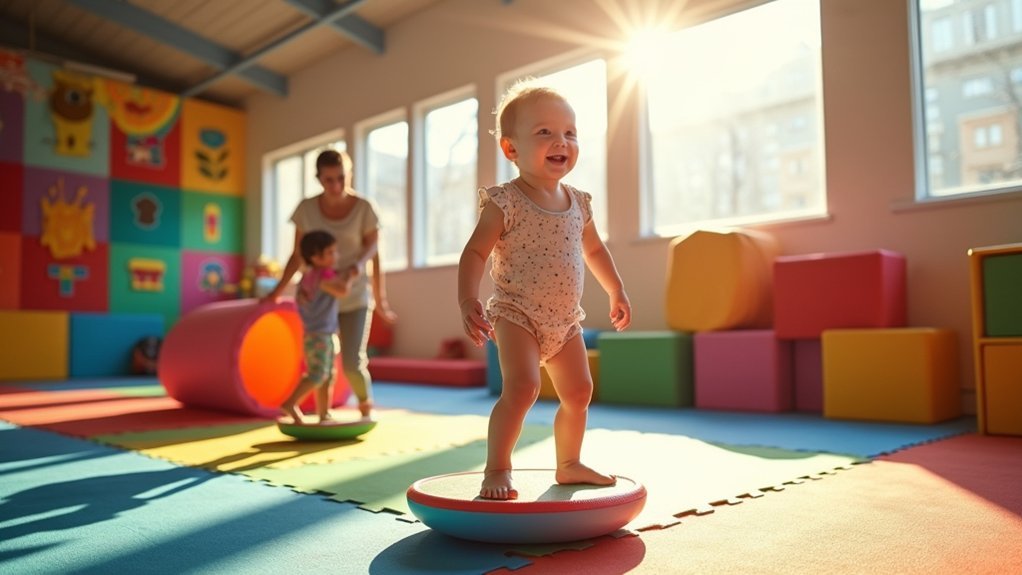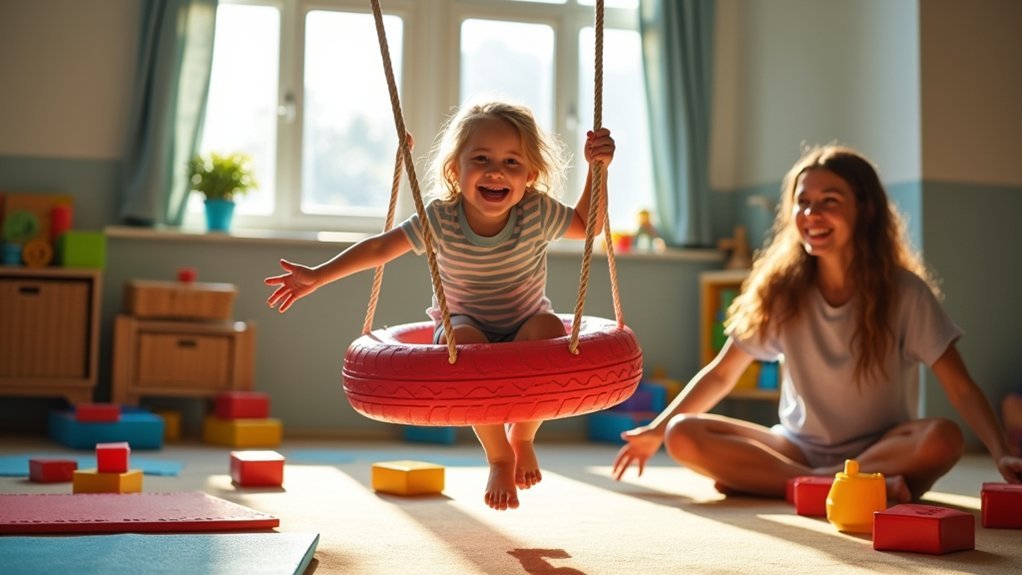Proprioceptive play matters for special needs children because it provides essential feedback about body position, helping them develop better coordination and body awareness. When your child jumps, crashes into objects, or chews non-food items, they’re seeking this sensory input. These activities send calming signals to the nervous system, improving self-regulation, focus, and emotional stability. You’ll notice immediate benefits from simple activities like wall pushes or weighted blankets. Discover how to create an effective sensory environment that transforms challenging behaviors into developmental opportunities.
Understanding Proprioception in Special Needs Development

When children with special needs struggle with body awareness and coordination, their proprioceptive sense often needs targeted attention. This sensory system gives critical feedback about body position and movement, helping kids understand where they’re in space.
For those with sensory processing challenges, particularly autism, proprioception serves as an internal GPS. You’ll notice proprioceptive-seeking behaviors like jumping, crashing into furniture, or squeezing into tight spaces—these aren’t behavioral issues but signs your child craves sensory input to feel regulated.
Your occupational therapist can assess your child’s specific sensory needs and recommend appropriate activities.
Working with a qualified OT ensures your child receives personalized sensory strategies tailored to their unique profile.
Proprioception can be both calming and alerting, making it a versatile tool for helping your child shift between activities or manage overwhelming situations throughout their day.
Key Signs of Proprioceptive Seeking Behaviors
You’ll notice proprioceptive seeking children through their distinctive body movements, including running, jumping, and leaning heavily against furniture.
Watch for repetitive actions like hand-banging or frequent falling, which serve as their way to gain sensory feedback about body position.
Oral indicators are equally revealing, as children who chew on sleeves, pencils, or other non-food items are often seeking the proprioceptive input that helps them feel regulated and grounded.
Recognizing Body-Seeking Movements
Children with proprioceptive processing challenges often display distinct physical behaviors that signal their body’s need for sensory input. If you notice your child frequently crashing into surfaces or falling to the ground deliberately, they’re likely seeking deep pressure to regulate their system.
| Body-Seeking Movement | Proprioceptive Purpose |
|---|---|
| Running/jumping | Provides joint compression for body awareness |
| Leaning on furniture/people | Seeks deep pressure input |
| Falling deliberately | Creates impact sensation for feedback |
| Biting/chewing objects | Activates oral proprioceptive input |
| Squeezing/pushing objects | Delivers resistance for muscle awareness |
These actions aren’t misbehavior but essential strategies children with autism use to gain proprioceptive input. By recognizing these body-seeking movements, you’ll better understand when your child needs sensory-rich activities to help them feel organized and regulated throughout their day.
Oral Chewing Indicators
Five distinct oral behaviors signal a child’s need for proprioceptive input through their mouth and jaw. Watch for children who frequently chew on non-food items like shirt sleeves, pencils, or toys.
You’ll notice they seek crunchy foods or constantly chew gum when available. These oral chewing patterns are especially common in children with autism who use this sensory strategy to regulate their emotional state and ground themselves.
When children bite, suck, or chew intensely, they’re activating jaw proprioceptors that provide essential body awareness feedback. This isn’t random behavior—it’s a purposeful attempt to satisfy an under-responsive proprioceptive system.
Supporting healthy proprioceptive development means offering appropriate chewable alternatives like specialized chewy toys or crunchy snacks that meet their sensory needs while redirecting them from potentially harmful chewing habits.
The Science Behind Proprioceptive Input and Self-Regulation

When your child engages in proprioceptive activities, their nervous system receives powerful calming signals that help regulate emotions and behavior.
These calming effects occur because proprioceptive receptors in joints and muscles send organized messages through the spinal cord directly to brain regions responsible for self-regulation.
You’ll notice this joint-brain connection pathway works almost immediately, which explains why activities like wall pushes or weighted blankets can quickly transform an overwhelmed child into a more focused, regulated state.
Proprioception’s Calming Mechanism
Although often overlooked, the proprioceptive system serves as a powerful natural regulator for our nervous system, especially for those with special needs.
When your child receives proprioceptive input through activities that engage muscles and joints, they’re activating a built-in calming mechanism that helps them process sensory information more effectively.
- Deep pressure activities like bear hugs provide immediate calming effects for children with autism spectrum
- Weighted blankets stimulate proprioceptive receptors, reducing anxiety during sensory overload
- Push-pull games help children feel more organized when they’re overwhelmed
- Heavy work activities improve focus and prepare children for daily tasks
- Consistent proprioceptive input enhances sensory processing and emotional regulation
You’ll notice that after engaging in these calming strategies, your child may demonstrate improved self-regulation and readiness to tackle challenging situations.
Joint-Brain Connection Pathway
The inner workings of proprioception reveal a fascinating connection between your child’s body and brain. When your child jumps, pushes, or pulls, receptors in their joints and muscles send essential signals that strengthen neural pathways significant for sensory processing.
This joint-brain connection doesn’t just happen—it’s actively built through proprioceptive input. When your child engages in “heavy work” activities, they’re not just moving; they’re creating a biological feedback loop that releases neurotransmitters supporting emotional regulation and focus.
For children with special needs, this pathway is particularly important. The body awareness developed through proprioceptive activities helps them navigate their environment with greater confidence.
You’ll often notice improved coordination and self-regulation after consistent proprioceptive play, as these neural connections become stronger and more efficient over time.
Essential Equipment for Heavy Work Activities
Five key pieces of equipment can transform your proprioceptive play sessions for children with special needs.
When you’re planning heavy work activities, the right tools will greatly enhance proprioceptive input and improve focus during sensory tasks.
- Weighted vests provide deep pressure input that helps children feel grounded during structured activities.
- Resistance bands create opportunities for pushing and pulling exercises that build muscle strength.
- Medicine balls and weighted backpacks encourage lifting and carrying, delivering powerful proprioceptive feedback.
- Sensory swings combine vestibular and proprioceptive input, supporting self-regulation.
- Household items like laundry baskets filled with clothes offer functional ways to engage in heavy work.
You don’t need expensive equipment to start—many effective tools for proprioceptive play can be found right in your home.
Creating an Accessible Sensory Gym at Home

Creating an accessible sensory gym at home extends beyond collecting equipment—it transforms ordinary spaces into therapeutic environments for your child with special needs.
Designate a safe area with soft mats or crash pads where your child can jump, roll, and crash safely while receiving valuable proprioceptive input.
Incorporate heavy work opportunities using household items like laundry baskets or pillows for obstacle courses. Add weighted blankets and resistance bands to provide deep pressure that helps with body awareness.
Don’t forget essential calming tools such as compression vests and fidget toys that enable your child to self-regulate during sensory overload.
Keep the environment fresh by rotating activities and equipment regularly to address varying sensory needs.
With thoughtful planning, you’ll create a space that supports both active movement and sensory regulation.
Outdoor Proprioceptive Play Solutions
Natural environments offer unparalleled opportunities for children with special needs to engage their proprioceptive system while enjoying fresh air and sunshine.
For children with ASD, these sensory experiences can provide essential developmental benefits while making therapy feel like play.
Heavy work activities outdoors help regulate sensory processing and improve body awareness:
- Install climbing structures where your child can pull, push, and navigate obstacles
- Set up trampolines or swings that provide proprioceptive input can help calm or energize depending on your child’s needs
- Encourage digging in sand or moving rocks to experience natural resistance
- Organize group activities like tug-of-war that combine social skills with powerful proprioceptive feedback
- Create sensory paths with varied textures (grass, gravel, rubber) to enhance spatial awareness while engaging in activities that challenge balance
Indoor Movement Equipment for Limited Spaces
Even without access to expansive outdoor areas, families can still provide meaningful proprioceptive experiences through carefully selected indoor equipment. Mini trampolines and balance boards deliver essential proprioceptive input while requiring minimal space, helping your child develop body awareness and coordination.
Consider compact options like sensory swings or foam balance beams that fit easily into small living areas. Weighted blankets and vests offer calming proprioceptive feedback during indoor activities, helping your child feel grounded and focused.
Small but mighty sensory tools that fit your space while helping your child find balance and calm when they need it most.
Resistance bands and therapy putty serve as portable tools that strengthen muscles through pushing and pulling motions.
Incorporating these indoor movement equipment options into daily routines helps children with special needs develop motor skills while reducing anxiety—creating opportunities for meaningful proprioceptive play regardless of spatial constraints.
Proprioceptive Equipment for Classroom Settings
While traditional classroom settings often prioritize stillness, integrating proprioceptive equipment creates essential movement opportunities for students with special needs.
You’ll find these tools particularly valuable for students with autism who struggle with sensory processing challenges.
- Weighted vests and lap pads deliver calming deep pressure input, helping students maintain focus during learning activities.
- Sensory swings and therapy balls allow controlled movement that stimulates the proprioceptive system.
- Compression garments provide consistent pressure, reducing anxiety and improving engagement.
- Resistance bands and therapy putty encourage fine and gross motor development while meeting sensory needs.
- Occupational therapy professionals can guide you on implementing these tools effectively for individual students.
Adaptive Sports Equipment for Sensory Integration
Moving beyond the classroom environment, adaptive sports equipment offers powerful proprioceptive benefits for children with special needs in more dynamic settings. Modified bikes and specialized wheelchairs provide essential proprioceptive input through movement and coordination challenges that promote sensory integration in a fun, engaging context.
You’ll find that equipment like weighted vests and balls deliver deep pressure during activities, helping children regulate their sensory experiences while participating in sports. Sensory-friendly gear with soft padding and adjustable features guarantees comfort without overwhelming sensitive systems.
These adaptive tools foster not only improved motor skills but also valuable social development as children engage with peers in team settings.
Research confirms that when you incorporate specialized sports equipment, children develop better self-regulation and confidence while processing sensory information more effectively.
DIY Proprioceptive Tools on a Budget
Creating effective proprioceptive tools doesn’t require expensive specialized equipment when you have access to common household items. You can easily craft sensory activities that provide meaningful proprioceptive input while staying within your budget.
- Fill a backpack with books for wearable weight that delivers deep pressure as your child moves.
- Create textured sensory bins using rice, beans, or sand for tactile play that engages proprioceptive feedback.
- Make homemade therapy putty from flour, salt, and water to strengthen hand muscles.
- Build obstacle courses with cushions and boxes for climbing and crawling heavy work activities.
- Craft a tug-of-war rope from old fabric scraps to promote cooperative play while stimulating the proprioceptive system.
These DIY proprioceptive tools offer affordable alternatives to specialized equipment while providing the same sensory benefits for your child’s development.
Selecting Age-Appropriate Proprioceptive Equipment
Selecting the right proprioceptive equipment for your child extends beyond budget considerations to address their specific developmental needs and age requirements. Safety and effectiveness should be your primary concerns—younger children typically need softer, lighter tools while older children benefit from more challenging equipment.
Work with an occupational therapist to guarantee proper sizing of weighted vests and compression garments, preventing movement restriction while maximizing proprioceptive input. For younger children, consider soft crash pads and foam blocks; older children might prefer balance boards and resistance toys for deeper sensory feedback.
Introduce new proprioceptive equipment gradually, allowing your child time to adjust to unfamiliar sensations. Whenever possible, involve your child in selecting their tools—this ownership increases engagement and motivation during sensory activities, making proprioceptive play more effective and enjoyable.
Measuring Progress Through Proprioceptive Play
Tracking your child’s development through proprioceptive play provides essential insights into their sensory integration journey while helping you adjust interventions for maximum benefit.
By systematically observing changes in coordination and muscle control, you’ll gain valuable data about your child’s responsiveness to sensory input and proprioceptive processing.
- Document the frequency and duration of proprioceptive activities to identify behavioral patterns
- Evaluate performance in specific tasks like obstacle courses or heavy work activities
- Utilize structured assessment tools such as the Extensive Observations of Proprioception scale
- Note qualitative changes in your child’s engagement and reactions during play sessions
- Compare current abilities against baseline measurements to quantify improvement
This methodical approach helps you tailor therapeutic strategies more effectively while celebrating even small improvements in your child’s proprioceptive development journey.
Combining Proprioceptive Activities With Other Sensory Inputs
You’ll find greater therapeutic impact when you combine proprioceptive activities with vestibular and tactile inputs to create extensive sensory experiences for children with special needs.
Try creating obstacle courses that involve climbing and crawling to simultaneously engage both proprioceptive and vestibular systems, or incorporate weighted objects during movement activities for calming deep pressure.
These multisensory approaches can greatly improve your child’s attention, body awareness, and ability to process environmental information while making therapy sessions more engaging and effective.
Multisensory Integration Benefits
While proprioceptive activities alone offer significant benefits, combining them with other sensory inputs creates a powerful synergistic effect for children with special needs.
When you incorporate multisensory integration into your child’s routine, you’re helping their brain process information more effectively, improving overall sensory processing capabilities.
- Pairing proprioceptive input with tactile experiences enhances body awareness and coordination.
- Combining jumping activities with rhythmic music strengthens both motor planning and communication skills.
- Adding visual elements to pushing games improves attention and focus, especially for children on the autism spectrum.
- Integrating vestibular activities with proprioceptive ones helps regulate emotional responses to environmental stimuli.
- Multisensory activities strengthen neuronal connections, increasing engagement and participation in daily tasks.
Vestibular-Proprioceptive Combinations
Proprioceptive activities reach their full potential when paired strategically with vestibular inputs, creating powerful sensory experiences that address multiple processing needs simultaneously. When you combine swinging (vestibular) with pushing or pulling actions (proprioceptive), you’re stimulating complementary sensory systems that enhance body awareness and spatial orientation.
| Vestibular Input | Proprioceptive Activity | Benefit | Best For |
|---|---|---|---|
| Spinning | Carrying weighted items | Enhanced balance | Sensory seeking children |
| Swinging | Pushing/pulling | Improved coordination | Body awareness challenges |
| Rolling | Crawling activities | Better spatial orientation | Motor planning difficulties |
| Balance boards | Heavy work tasks | Dual sensory integration | Self-regulation needs |
Design obstacle courses that incorporate climbing, jumping, and swinging to maximize sensory integration benefits. These combinations provide the multi-faceted experiences that calm and alert simultaneously, making them ideal for children with special sensory processing challenges.
Tactile-Enhanced Movement Play
Enhancing proprioceptive play with tactile elements creates a multi-sensory experience that amplifies developmental benefits for children with special needs.
When you combine textured surfaces with movement activities, you’re helping children develop body awareness while processing varied sensory input.
These tactile-proprioceptive combinations offer powerful developmental support:
- Jump on a trampoline with different textured materials to simultaneously engage proprioceptive and tactile systems
- Create sensory tunnels filled with soft materials for crawling, providing calming input while encouraging movement
- Use weighted, textured objects during play to regulate emotional responses while building muscle strength
- Incorporate sensory bins into obstacle courses to enhance coordination and reduce anxiety
- Provide varied tactile feedback during proprioceptive activities to improve social interaction as children navigate different sensations together
Frequently Asked Questions
What Are the Benefits of Proprioceptive Activities?
Proprioceptive activities improve your body awareness, regulate emotions, reduce anxiety, enhance motor skills, and boost sensory integration. You’ll experience better coordination, increased focus, and improved physical fitness through regular participation in these activities.
How Does Proprioception Affect Autism?
Proprioception affects your child with autism by improving their self-regulation and body awareness. You’ll notice better coordination, reduced anxiety, and enhanced focus when they engage in activities that provide deep pressure sensory input.
Why Is the Proprioceptive System Important?
Your proprioceptive system helps you know where your body is in space. It’s essential for coordination, balance, and self-regulation. Without it, you’d struggle with everyday movements and controlling your physical responses effectively.
Why Do Some Kids Need Proprioceptive Input?
Some kids need proprioceptive input because you’ll notice they seek body awareness through movement. They’re regulating their sensory systems, improving coordination, and finding calm. Without it, they’ll struggle with attention and motor skills.
In Summary
You’ve now got the tools to understand and support your child’s proprioceptive needs. Whether you’re using specialized equipment or DIY solutions, you’re helping them develop essential body awareness and self-regulation skills. Remember, consistency is key—incorporate these activities into your daily routine. As you continue this journey, you’ll notice improvements in your child’s confidence, coordination, and emotional regulation. Keep celebrating every small victory along the way.





Leave a Reply